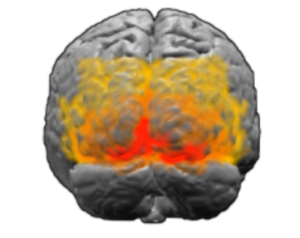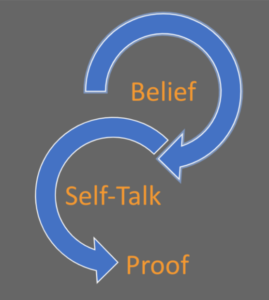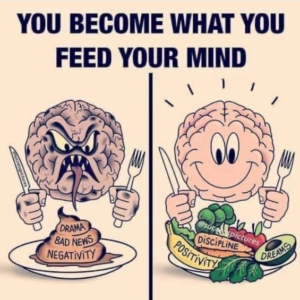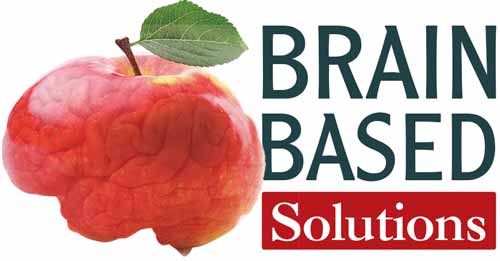I just had a thought! Am I in control of my thoughts? Hmmm. How would I know? Are you in control of your thoughts?
In this blog, we’re diving into key brain mechanisms to understand what really happens when we have a thought – and how you can change your thoughts for a healthier, happier life.
First, Let’s Review the Brain
Your brain is composed of the cerebellum and four lobes, each one more or less responsible for functional outputs in your daily existence. For instance, when sensory information enters the left eye (retina) it passes through the entire brain, crosses over at the optic chiasm to the right side, and is processed in the visual cortex at the right side of the back brain (occipital).
The brain stem connects the brain to the spinal cord. It is responsible for routing information to and from the central nervous system (CNS) to the brain. It is vital for regulating many of the functions that keep you alive every moment of every day. It regulates balance, coordination, reflexes, breathing, swallowing, facial sensations, heart rate, blood pressure, and more.
What Your Brain Knows: The Reticular Activating System

When considering your thoughts, it is important to note that your brain stem controls your reticular activating system (RAS). This small clump of neurons is responsible for sending and receiving cell signals and chemicals throughout your brain. It also manages your sleep cycle and wakeful state and is vital to your alertness and attentional focus on your surroundings.
Along with all this, the RAS does quite a lot of information processing. The numbers associated with your brain on a daily basis are astounding. First, it uses a lot of valuable resources: 20% of your body’s oxygen, 20% of your body’s fuel (glucose), 25% of your body’s blood).
So what is it doing to warrant all that energy and resource use?
Information Overload
11,000,000 bits of data assail your brain each second. Think about it. Ambient sounds, visual stimuli, smells, touch, and taste. Information coming in from your toes, your knees, your heart, your blood. The sensations of pain and temperature.
Take a deep breath in. In that time, eleven million pieces of information have been processed by your brain in the time it took you to count to one.
You get the picture.
The truth is, we humans would get overloaded and our brains would shut down if we had to deal with that amount of information in our conscious brain.
In other words, the brain takes care of most of it in the background. It is judging that you are breathing, your heart is beating, your eyes are blinking and you do not have to think about any of that information.
In fact, less than 1% of incoming sensory information gets admitted into your conscious brain. Thankfully your brain is very stingy with allowing sensory input into your conscious brain.
But how does it decide what to let in and what to keep in the background?
That is your RAS’s job. The RAS is a small clump of neurons sitting on the brain stem that makes important decisions about what to leave in and what to keep out.
What’s the Point of Positivity?
Why have a positive mindset? That question might seem superfluous or even redundant, but in fact, when you know the science behind why it is dangerous to not be positive, your world will change.
For instance, if you knew that your telomeres were listening to your thinking you might re-evaluate your thinking.
Telomeres are tell-tale aging reminders (aglets on the ends of every chromosome that wear out when we are stressed, sad, or angry) that introduce gray hairs, baldness, skin problems, inflammation, and other health risks as we get older.
Sometimes when we go to our fifteen or thirty-year school reunion, we look at someone we haven’t seen in a long time and wonder, “She hasn’t changed one bit! Still as beautiful and fresh as she was back in high school.” But then we meet another person and think “Wow, wonder what happened to him, he looks like his grandfather.”
This comes down to the RAS and telomeres. Stress, negative thinking, epigenetic factors that came about because of the choices she or he made during the life journey have an impact on our mental and physical health.
What if you found out that you were heading for premature aging? Wouldn’t that get your attention? And what if you find out that your telomeres were listening to your thoughts?
I would want my telomeres to only hear positive thinking, happy days. Because at the molecular level, our cells are sensitive to mood, negativity, resentments, anger, selfishness, and so on.
The RAS and Positive Thinking

So what has the RAS got to do with telomeres?
This brain filter for sensory information will be informed by and reinforce your beliefs. It’s like a self-fulfilling prophecy. As parents and teachers, we see it every day. A child will say something like “I’m no good at math” or “I can’t play soccer as good as Maria.”
Yet, we know that this is not true. We know that the child just needs to apply herself, practice with intention, and watch the improvement happen. Yet, chances are high that that child will progress through school and life ‘knowing and proving’ that she is no good at math or soccer.
The RAS does a great job of confirming our beliefs.
If I believe that I am a great chess player, my RAS will give me confirming evidence every time I play that I am very good at chess. I find this news welcoming and it makes it easy to practice, to put in the concentrated hours it takes to become champion.
Meanwhile, the student who believes and gets frequent confirming feedback from his RAS that he is not good enough at chess will give up and walk away defeated.
Your RAS makes 90% of your decisions without you even knowing it. So where did the RAS get the information to sustain this power over my thinking? Sometimes positive, sometimes negative. RAS gets fed from you. YES, you!
First, the RAS is hardwired to react to certain environmental items that are prevalent in today’s world but have deep roots in a much older world. I am referring to a primordial survival world, which might more easily be described as a time of ‘jaws’ and ‘claws.’
Homo sapiens managed to eke out a precarious existence in a time when other species (Neanderthals, Homo erectus, etc.) didn’t make it. RAS was very active in filtering information that was necessary for survival at a time when you might just as easily be eaten by something or someone else.
As a result, today we are volitional, goal-directed beings. Almost everything we do in our daily lives is goal-directed. When we make decisions that have outcomes and consequences we are acquiring agency. A sense of agency is defined as one’s sense of control over one’s actions and consequences. The RAS plays into both of these ideas: goal-directed and agency. Actions and consequences occur in the everyday environment, but why and how we carry out these actions is very connected to how the RAS enforces its ‘rules.’
- RAS is hardwired to notice danger, to cause you to leap for safety when you hear the squeal of brakes as you walk on the sidewalk. Leap first; think about it afterward.
- RAS is also looking for surprises. Your state of alertness is tuned to recognize something novel or surprising. Notice how many teachers use this RAS knowledge to their advantage – showing up in the classroom each day in a surprising costume that automatically garners student attention. No need to say ‘Pay Attention.”
- RAS makes it so that a mother (or father) can pick out their child’s cry in a crowded noisy room – because RAS is attuned to filter in the sound (especially the needy call) of a child. All other sounds are filtered out until the parent is satisfied that the child is safe.
- RAS is also looking for something that is unpredictable. The brain likes predictability; anything that falls outside that norm will show up as attention-worthy to RAS.
It’s my RAS. I tell my RAS what to filter in and what to filter out. I get help of course, from my environment and from my genes. If I don’t even know I have a RAS (most people don’t) it is all happening in the background.
This is how it works. I grew up in a particular household; with a family; in a neighborhood and because of that my environment gives me certain standards and norms and ideas and beliefs. These feed into my construction of the world. I make sense of my environment based on my experiences. Therefore my RAS filters are generated from that geography, that socioeconomic existence, that side of the track, that zip code, that food, that school, that teacher, and so on.
But there’s more. Environment and growing up (experiential) history contribute to RAS. But before these epigenetic factors, I was given very specific genetic keys from my biological mom and dad that also impacted how my RAS interacts with the world.
- Some of us received genetic factors that caused us to be highly resilient. We are like dandelions; we could survive in a crack in the concrete.
- Some of us received very different genetic codes that cause us to be entirely sensitive. We are like orchids; we need a greenhouse environment in order to flourish and thrive.
The primary goal for RAS is to ensure our survival. Over millions of years of evolutionary practice, the brain has figured out a practical and efficient way to do that.
Your brain is efficient and hardworking. Its main purpose is to keep you safe in an unpredictable world. In that process of gaining efficiency through rules, our brains evolve personal biases that inform our actions and beliefs. These ‘rules’ can also be viewed as cognitive shortcuts. Shortcuts can be good, but conversely, they can deliver unexpected outcomes.
RAS is hardwired to create cognitive shortcuts using memories of past experiences to make assumptions for future survival so we can move through the world effectively and efficiently.
We’ve been acquiring these cognitive shortcuts since before we were born – through experiences in the womb, in our own families, our circle of friends, sports, clubs, churches, languages we speak, and so on. All these items inform our beliefs and what we know to be true about the world around us.
RAS was actively listening to our body language in all of these activities. Some activities we liked. Some we didn’t like. And RAS was listening. RAS made rules based on what we liked and didn’t like. Along the way, we, like everyone else, became prey to, acquired, and propagated inaccurate information, misconceptions that allowed us to make snap judgments. Blind spots with implicit biases.
Implicit bias refers to our unconscious attitudes and stereotypes that shape our responses to people, places, and things. Implicit bias like RAS, operates involuntarily, often without our awareness or intentional control. And it all comes from the messages, attitudes, and social norms that we pick up along the way.
Can We Change How the RAS Sees Our World?

So am I stuck with my RAS ‘rules’ my blind spots and my implicit biases? Absolutely not!
That’s what education is for. Education is a form of neural plasticity. I used to have this conception of my pace in the world. You taught me something and now I have conceptual change. I am able to assimilate new information with prior knowledge; I am able to rewire my own brain. My constructs, conceptions, and ideas are merely brain circuits; wiring that has been put in place by my lived experience, my reading, my schooling, my discussions with parents, siblings, teachers, peers, and so on.
But I’m not stuck with that rigid thought or idea. Plasticity is a huge part of my growing, developing brain. Conceptual change is a good example of neuroplasticity. I used to think that; now I think this. I can see both items, but I choose to go with this one – since I learned this new information.
There is plenty of room in the brain to manage this kind of decision-making; an informed decision-making process that is helping define how RAS makes rules.
Recap: Think Positive and Change Your Life
Sure, it’s because I feel good when I have positive thoughts. Knowing the science behind positivity is a great boost. First, a deep understanding of neural plasticity informs me that I can change my brain, I can change my outlook on life, and I can change my journey.
Second, I want my telomeres to experience a happy positive me so that my frayed aglets of time are not worn out too early.
And finally, when I take charge of my RAS, load it with filter moments that interpret and engage in the world from a healthy and happy perspective, my world is not only warmer, more inclusive and meaningful, it is inviting, supportive, and fun.
That sense of control over one’s own actions and consequences (sense of agency) is an important component of self-awareness as it helps me determine my impact on the external world. This sense of agency has been linked with increased well-being and fulfillment.
Children got it right. Altruism is best. Play and a childlike approach to living work. Think positively to change your brain – and change your life!

